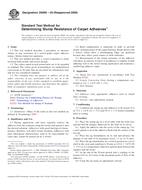Wir benötigen Ihre Einwilligung zur Verwendung der einzelnen Daten, damit Sie unter anderem Informationen zu Ihren Interessen einsehen können. Klicken Sie auf "OK", um Ihre Zustimmung zu erteilen.
ASTM D7616/D7616M-11
Standard Test Method for Determining Apparent Overlap Splice Shear Strength Properties of Wet Lay-Up Fiber-Reinforced Polymer Matrix Composites Used for Strengthening Civil Structures
Automatische name übersetzung:
Standard Test Methode zur Bestimmung der Schein Overlap Splice Scherfestigkeit Eigenschaften von Wet Lay-Up faserverstärkten Polymer Matrix Composites Wird für die Stärkung der Zivilstrukturen
NORM herausgegeben am 1.5.2011
Informationen über die Norm:
Bezeichnung normen: ASTM D7616/D7616M-11
Anmerkung: UNGÜLTIG
Ausgabedatum normen: 1.5.2011
SKU: NS-38833
Zahl der Seiten: 7
Gewicht ca.: 21 g (0.05 Pfund)
Land: Amerikanische technische Norm
Kategorie: Technische Normen ASTM
Kategorie - ähnliche Normen:
Die Annotation des Normtextes ASTM D7616/D7616M-11 :
Keywords:
ICS Number Code 83.180 (Adhesives)
Ergänzende Informationen
| Significance and Use | ||||||||||||||||||||||||
|
Overlap splices are used in field applications of FRP composites when site conditions prohibit continuous access to a structural element or when the specified length of the FRP composite is such that saturation and placement of the entire length would be cumbersome. This method can be used as a quality control mechanism for ensuring that overlap splices constructed under field conditions meet or exceed the requirements established by the design engineer or FRP system manufacturer. Both the saturant mixing and fiber saturation method can be verified for wet-layup FRP systems. Caution is recommended when interpreting apparent shear strength results obtained from this method. Single shear lap splices develop non-uniform shear stress distributions within the overlap splice region during testing. Additional guidance on the interpretation and use of results obtained from lap shear testing is found in D4896. This test method focuses on the FRP material itself, irrespective of gripping method. Therefore, strengths resulting from failure or pullout at either grip are disregarded. The strength measurements are based solely on test specimens that fail in the gage section (away from the grips) or at the splice. |
||||||||||||||||||||||||
| 1. Scope | ||||||||||||||||||||||||
|
1.1 This test method describes the requirements for sample preparation and tensile testing of single-lap shear splices formed with fiber-reinforced polymer (FRP) composite materials commonly used for strengthening of structures made of materials such as metals, timber, masonry, and reinforced concrete. The objective of this method is to determine the apparent shear strength of an overlap splice joint through the application of a far-field tensile force. The method applies to wet lay-up FRP material systems fabricated on site or in a laboratory setting. The FRP composite may be of either unidirectional (0°) or cross-ply (0/90 type) reinforcement. For cross-ply laminates, the construction may be achieved using multiple-layers of unidirectional fibers at either 0 or 90°, or one or more layers of stitched or woven 0/90 fabrics. The composite material forms are limited to continuous fiber or discontinuous fiber-reinforced composites in which the laminate is balanced and symmetric with respect to the test direction. The method is often used to determine the length of the overlap splice needed to ensure that a tension failure occurs in the material away from the splice rather than the splice connection itself. 1.2 The values stated in either SI units or inch-pound units are to be regarded separately as standard. The values stated in each system may not be exact equivalents; therefore, each system shall be used independently of the other. Combining values from the two systems may result in non-conformance with the standard. 1.2.1 Within the text, the inch-pound units are shown in brackets. 1.3 This standard does not purport to address all of the safety concerns, if any, associated with its use. It is the responsibility of the user of this standard to establish appropriate safety and health practices and determine the applicability of regulatory limitations prior to use. |
||||||||||||||||||||||||
| 2. Referenced Documents | ||||||||||||||||||||||||
|
Ähnliche Normen:
Historisch
1.11.2009
Historisch
1.4.2012
Historisch
1.4.2011
Historisch
1.4.2011
Historisch
1.4.2011
Historisch
1.1.2011
Empfehlungen:
Aktualisierung der technischen Normen
Wollen Sie sich sicher sein, dass Sie nur die gültigen technischen Normen verwenden?
Wir bieten Ihnen eine Lösung, die Ihnen eine Monatsübersicht über die Aktualität der von Ihnen angewandten Normen sicher stellt.
Brauchen Sie mehr Informationen? Sehen Sie sich diese Seite an.



 ASTM D6005-03(2009)..
ASTM D6005-03(2009).. ASTM D6123/D6123M-97..
ASTM D6123/D6123M-97.. ASTM D6195-03(2011)..
ASTM D6195-03(2011).. ASTM D6252/D6252M-98..
ASTM D6252/D6252M-98.. ASTM D6295/D6295M-98..
ASTM D6295/D6295M-98.. ASTM D6325-98(2011)..
ASTM D6325-98(2011)..
 Cookies
Cookies
